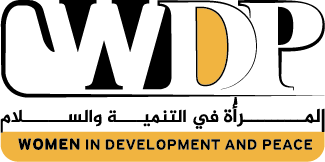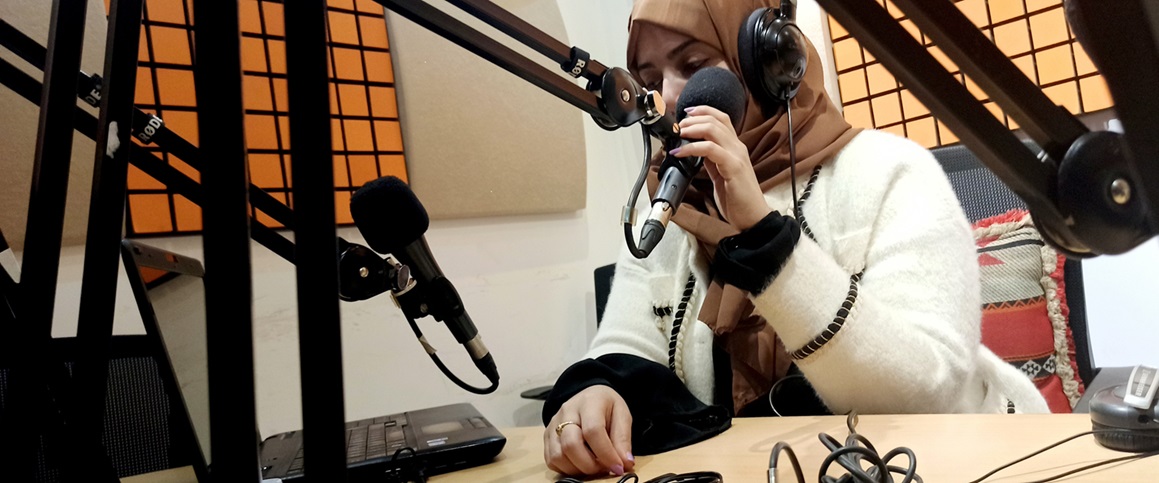Women in Development and Peace – Hanan Hussein
In recent times, the Yemeni media has witnessed significant developments, especially in the women’s sector. While female journalists were once few, today there are many presenters, journalists, and media professionals, all with unparalleled efficiency and distinction.
Shift Between the Past & Present
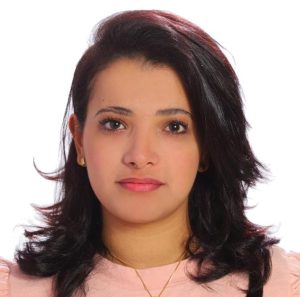
According to Yemeni journalist Yerstin Al-Nahmi, the media landscape for women has shifted significantly compared to the past, particularly during the armed conflicts in Yemen. She emphasized the significant challenges women journalists faced in the past, highlighting the extent of discrimination between men and women in the media field.
Lamia Abdul-Karim, a radio presenter, noted that in the past, women were limited to specific media programs and faced social restrictions and negative perceptions. However, she highlighted the current expansion and diversity of media content, along with the esteemed recognition of women in this field.
Competition & Rejection
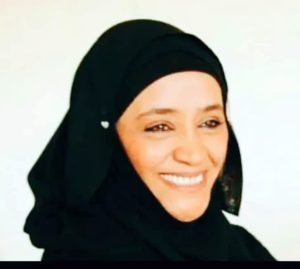 Muna Al-Bar, a radio presenter, is one of the presenters whose melodious voice has captivated the ears of the Yemeni audience. She spoke about the significant differences faced by Yemeni female media professionals, stating, “There are many differences between female media professionals in the past and present in Yemen. Despite the difficult circumstances, such as the lack of acceptance by society for their work in this sensitive field from the beginning, the female media professionals of the past struggled with and accepted this reality with their strong will and continuous struggle to change this perception within their small community first, represented by their family, and then in dealing with the society as a whole.”
Muna Al-Bar, a radio presenter, is one of the presenters whose melodious voice has captivated the ears of the Yemeni audience. She spoke about the significant differences faced by Yemeni female media professionals, stating, “There are many differences between female media professionals in the past and present in Yemen. Despite the difficult circumstances, such as the lack of acceptance by society for their work in this sensitive field from the beginning, the female media professionals of the past struggled with and accepted this reality with their strong will and continuous struggle to change this perception within their small community first, represented by their family, and then in dealing with the society as a whole.”
She adds, “She has worked on adapting to this rejection with her knowledge, culture, and distinction, as well as presenting programs and honing her talent to work in this field, possessing several qualities that qualify her for excellence, including: mastering the correct Arabic language, a distinguished voice, diverse and professionally prepared content. All of this effort that the media presenter has exerted in the past has forced everyone to accept and respect her, and recognize the importance of the message she has presented throughout her media career.”
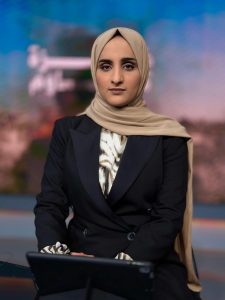
Shaima Al-Shara’abi, a TV and news program presenter, believes that the workplace for women has always been a place of competition with men since ancient times. She states, “In the past, Yemeni women faced rare appearances for several reasons, most notably: societal rejection of women’s work and entry into the labor market, as well as becoming speakers, journalists, and artists. This was something our society was not accustomed to. However, there are respected female media professionals who have broken this barrier and paved the way for us, the generation that sees that its girls have a great opportunity to appear and enter the field of media.”
Shaima adds, “Nowadays, this view has become less prevalent, but I am talking about how society, with the changing times and concepts, has become able to accept the presence of Yemeni women in the media, even though it still holds onto the nature of this appearance.”
Yerstin Al-Nahmi believes that many companies and media outlets have started to focus more on promoting diversity and the presence of women in the media, especially as news and program presenters. However, they are deliberately absent in other roles, such as program production, television news, filming, lighting, sound engineering, as well as supervision and directing.
Shaima Al-Shara’abi concludes her discussion about the differences between the past and present in the lives of Yemeni female media professionals by saying, “Nevertheless, the media remains a medium to bring ideas closer and to give the community an ideal image to understand our social phenomena; we criticize them, discuss them, and search for solutions to these problems within the framework accepted religiously and socially.”
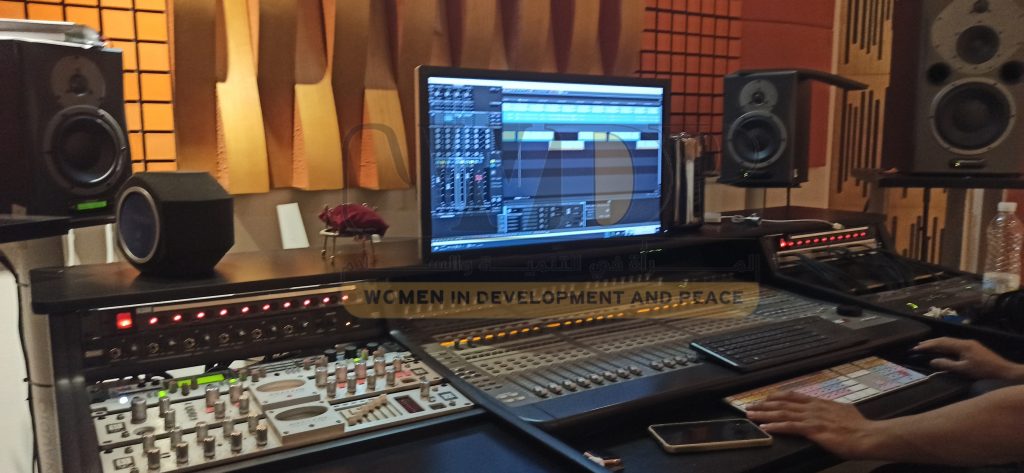
Limited Opportunities
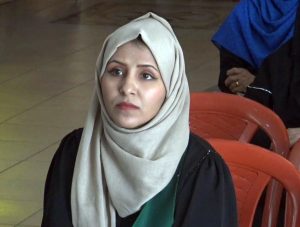 Shaima Abdallah, a TV presenter, believes that there have been changes in many aspects for women working in the media field from the past to the present. She says, “In the past, qualified female staff were few, and opportunities were limited. However, now women have taken on leadership positions, participated more in news presentation and content creation, and there are increased opportunities for women to reach high-level administrative and editorial positions in the media.”
Shaima Abdallah, a TV presenter, believes that there have been changes in many aspects for women working in the media field from the past to the present. She says, “In the past, qualified female staff were few, and opportunities were limited. However, now women have taken on leadership positions, participated more in news presentation and content creation, and there are increased opportunities for women to reach high-level administrative and editorial positions in the media.”
Shaima adds, “In addition, the present witnesses a shift towards presenting content that better reflects women’s issues, contributes to shaping diverse perspectives, and enables women working in the media to directly reach the audience through social media, increasing their impact, engagement, and interaction with the public.”
This is what Yerstin talked about in her discussion of the prominent differences in media opportunities for women in the field, saying, “In the past, women faced significant challenges in accessing employment opportunities and advancing in the media field. Opportunities for women were almost non-existent, and if they existed, they were confined to secondary and stereotypical roles. Cultural and social constraints hindered women’s progress and participation in this field. Nevertheless, some women managed to break through barriers and worked to build a brighter image of the importance of women’s presence in the media and journalism.”
Meanwhile, Saba Muhammad, a program manager at a local radio station, believes that the media field has become rich in opportunities, stating, “The most significant differences for women working in Yemeni media between the past and the present are that the field has become more open and opportunities are greater, regardless of the cultural level and awareness of the media’s mission as a message and authority in any country relied upon for change, improvement, and enhancing the community, which new female media professionals generally possess.”
She adds, “The field remains more open and accepting than in the past, regardless of the quality provided by the new female media professionals. This is something credited to Yemeni society in general between the past and the present.”
Gender Discrimination
Yerstin says, “When discussing gender equality in the media field, we must consider several important aspects. Firstly, we must acknowledge the improvement and changes that the industry has witnessed over the years.”
Yerstin confirms that the media industry has witnessed a significant transformation in recent years, thanks to the efforts of gender equality advocates, civil society organizations, and many female journalists who have fought numerous battles to assert their rightful place beyond societal constraints and the limited view of women in the media.
Weak Media Language
Presenter Muna Al-Bar adds that the present time contains many differences, saying, “For the media at present, the vast majority of male and female media professionals have turned to elevating the colloquial dialect at the expense of classical Arabic.”
She adds, “I do not believe that there is any benefit that the listener can gain at all stages of life from programs broadcast in the colloquial dialect. In the past, especially in radio, media outlets used to act as teachers who corrected the mispronunciations of words according to grammatical rules or the proper pronunciation of previous words.”
Muna elaborates, “Female media professionals have the ability to adapt and deal with all media and non-media work with very high skills. This lies in their nature, upbringing, and the burden they have been prepared to bear in building an entire nation and raising it. By nature, they deal with their children at different intellectual and mental levels. They have dealt with their brilliant children, absorbed them, and brought them to the prestigious scientific position they have reached. They have also similarly dealt with those who are less intelligent, dealt with everyone, and brought them to safety, despite the difficulties placed on their shoulders.”
Mastery & Proficiency
Yemeni women possess many skills that qualify them to work in various media fields. However, certain media content and programs are more suitable for the nature of Yemeni women, such as social, cultural, and humanitarian programs. Yemeni women are distinguished by their ability to effectively communicate with the audience and possess a high level of humanity that helps them in presenting programs addressing societal issues.
Shaima Abdallah believes that it is difficult to specify certain programs that women can discuss more than men. According to her, this ability depends on the interests, desires, and culture of each individual regardless of gender. However, what distinguishes women, in her view, are social programs that address issues specifically relevant to women, such as women’s issues, women’s health, and family programs that focus on mothers, children, families, and society. Women are capable of addressing and discussing these topics more than men.
Yerstin Al-Nahmi emphasizes that women play a major role and make significant contributions in preparing and presenting programs related to health, beauty, family, children, social and cultural development. She says, “Women are capable of producing these types of programs because they can understand the issues related to these fields, and they have unique insights and specialized knowledge in this regard. This has been proven despite being ignored by media leadership.”
She adds, “Women are absent from the political media field, even though they possess the necessary skills. Many women in the field today have the knowledge, creativity, excellence, management abilities, and political dialogue skills, but discrimination still exists.”
Saba Muhammad speaks about the prominent programs that women have been able to present, saying, “In general, female media professionals have been able to prove, with specific examples, that they are capable of mastering all media formats if given the appropriate opportunities by media institutions of all kinds. Realistically, if we superficially look at the matter in line with the job market, they have excelled in light morning entertainment programs close to the community.”
Media Privileges
Yerstin Al-Nahmi mentions that it cannot be denied that there are a number of privileges that women journalists have obtained; as media and journalism work in Yemen is now a challenge for both genders. She says, “One of those privileges is having greater opportunities for training and qualification by external entities, and perhaps also in the work itself, but all of this comes according to what the female journalist has presented in the Yemeni media arena first. Technological advancements have also contributed to increased communication and interaction with the audience, and to proving their presence in the media field more than before. Through this, female journalists have been able to surpass the limitations of channels and define their roles in journalism.”
Meanwhile, Saba Muhammad believes that the most important privilege obtained by Yemeni female journalists is what she spoke about from her point of view, saying, “Women in the media field have become more accepted in society suitably and differently than before. This is something to their credit and to Yemeni society, regardless of the negative examples that have damaged the image of female journalists, whether from the women themselves or from some media professionals.”
Lamia Abdul-Karim confirms that women have obtained several advantages, saying, “Women have gained many advantages, including a prestigious status, effective participation in media decision-making, as well as an increased presence in the media.”
Diligent Efforts
Muna Al-Bar speaks, saying, “Unfortunately, despite the diligent efforts made by women to enter the field of media work, and their outstanding efforts that are no less than those of men, they have not been more impressive and distinguished than men. Instead, they have been unjustly treated and deprived of their deserved rights in all aspects. They did not receive – like men – their right to obtain several benefits, such as: attending external courses abroad, and did not receive the financial rights they deserve according to their efforts, nor did they receive their right to be promoted in job grades, and their right to hold positions unlike their male counterparts. Only two personalities have seen the light, they are the media professor Amat Al Alim Alsoswa and the professor Dr. Raufa Hassan.”
She adds, “Despite the current abundance of female journalists, they are not armed with knowledge and expertise, nor are they interested in reading and learning like the previous female journalists, nor at the level of skills and culture of the previous female journalists,” according to Muna’s statement.
Most Prominent Difficulties
Muna Al-Bar speaks about the most prominent difficulties by saying, “The biggest challenges were familial and societal, but the Yemeni woman has emerged from the constraints imposed by traditional and societal ideas through the elevation and continuous renewal of her culture. She has worked to illuminate the darkness surrounding her and her community, effectively changing this negative perception through the effort she has exerted in reaching the level of excellence in her outstanding work.” Saba Muhammad sees the most prominent difficulties as what she mentioned in her statement: “The acceptance of society for women as professionals and messengers, with the right to be active and speak about their concerns and the issues of their community as women, as well as having a purely media perspective. In addition to the media templates in which the female media figure is placed, some have proven that they are capable of being comprehensive media professionals regardless of their gender.”
Shaima Abdullah sees the most prominent difficulties as she stated: “Despite all the progress we witness, women still face some challenges in the field of media, such as unequal wages and gender discrimination. However, there are ongoing efforts by women to address these issues.”
Meanwhile, Yerstin believes that some media institutions have worked on gender pay parity, stating: “One of the areas that has seen improvement is the equalization of wages between genders. In the past, women faced significant challenges in receiving equal pay to men in media professions. However, the focus has shifted towards achieving equality and providing support for women to demand equal pay for the same work, indicating significant progress in addressing the gender gap in the media field.”
Yerstin also adds that women in the Yemeni media field are absent from certain roles, saying: “There is a noticeable decline in the presence of women as field correspondents compared to the high percentage of males, as well as in leadership positions in the media arena. Accessing these positions poses a challenge in an environment that questions women’s abilities to bring about change and manage effectively.”
Solutions
Muna Al-Bar speaks, saying: “From my point of view, women are strongly present in the media field, but they just need to make every effort to develop their skills, build their capabilities, shine their voices, excel in the art of public speaking, enhance their culture and update their knowledge, obtain opportunities for training and qualification, advance in job grades, take opportunities in assuming administrative positions like their male counterparts, and avoid monopolizing positions by men.”
Saba Muhammad sees that the most prominent treatments are: revising media outputs, not exporting media content that adds nothing but shame to the profession, or giving society the impression that women are a form without substance.
Yerstin Al-Nahmi believes that it is important to achieve an effective and comprehensive change in all aspects of life, saying: “Efforts must continue to promote gender equality in the media industry, and companies and institutions must work to implement clear policies that promote equality and diversity in the workplace.”
Yerstin adds: “Opportunities for training and development for women must be provided, and their capacities enhanced to progress in their professional careers. In addition, the public sector and non-governmental organizations should work to raise awareness of the importance of gender equality in the media industry, and provide support and resources for initiatives that promote this goal.”
Meanwhile, Lamia Abdul-Kareem highlighted the solutions by saying: “The most prominent solutions to enhance women’s work in the media are the belief of Yemeni female journalists in their abilities, and the keenness to give them the opportunity to prove their presence in the field.”
